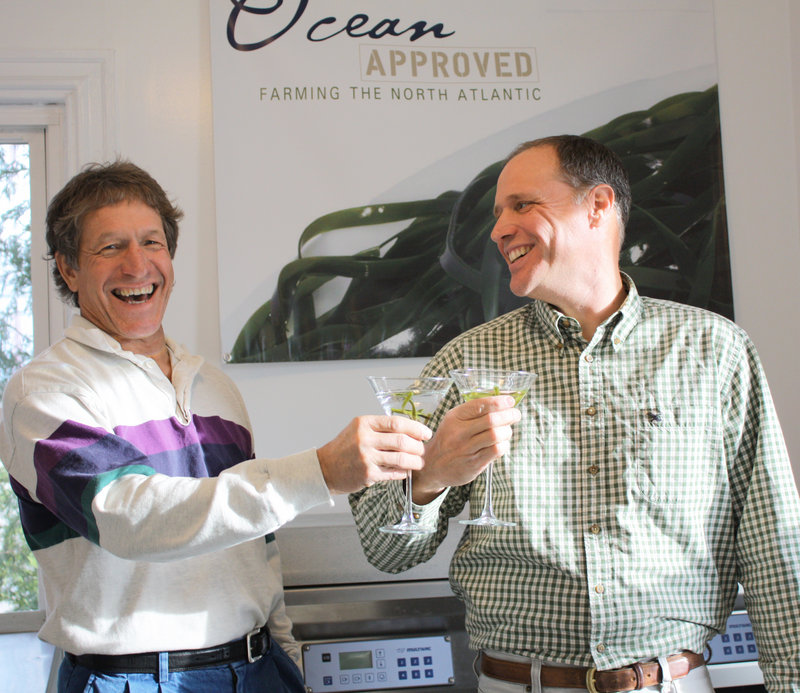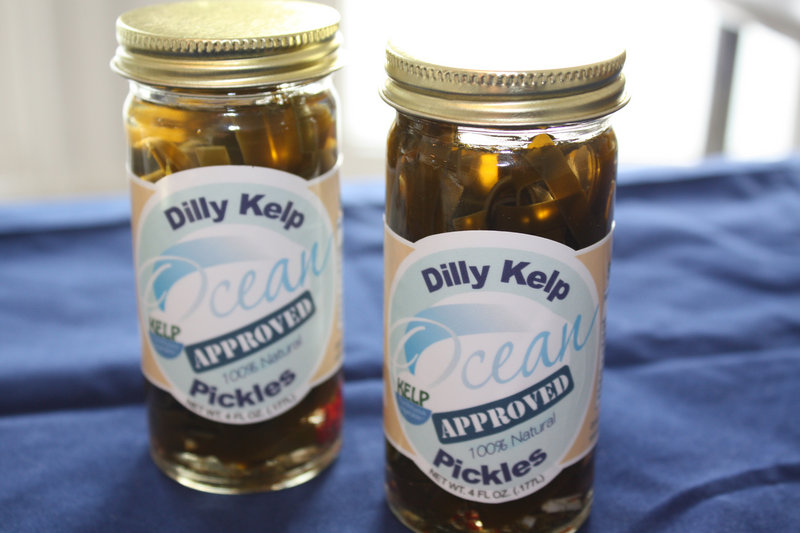After garnering rave reviews at this fall’s 20 Mile Meal and Harvest on the Harbor foodie events, Dilly Kelp Pickles can now be found in the refrigerated sections of local stores.
The newest product from Portland-based Ocean Approved features the company’s kelp noodles in a dill-infused vinegar brine. With a flavor that blends the essence of dilly beans and a subtle sea taste, the pickles have a slight crunch, and have the look of spinach noodles.
The Dilly Kelp can be used anywhere you would use pickles, such as sandwiches and burgers. However, they would make an excellent addition to tossed salads and bean salads and as an accompaniment to grilled fish.
Right now, you can find the 4-ounce bottles at Harbor Fish Market and Browne Trading Company in Portland, and soon at Hannaford.
The 3-year-old company also has another product in the works, Calendar Islands Cocktail Garnish.
With a brine that is slightly more salty than the Dilly Kelp’s, the cocktail garnish is intended as a replacement for olives in martinis, or “seatinis” as Ocean Approved owners Tollef Olson and Paul Dobbins call the drinks.
“It’s different than an olive but still adds the flavor,” said Dobbins.
In addition to these new products, Ocean Approved sells a unique line of cut, frozen kelp that has been precooked to al dente. Sold in flat packages in the freezer case, the kelp is bright green and just needs to be thawed before it is ready to eat.
Using only native Maine kelp grown at its aquaculture sites in Casco Bay and near Blue Hill, the company produces a Kelp Noodle Cut (the type used in the pickles and cocktail garnish) from sugar kelp, a Kelp Slaw Cut from horsetail kelp and a Kelp Salad Cut from winged kelp.
Each has a slightly different flavor and texture.
It’s a little-known secret of the prepared food world that most seaweed salads are dyed with artificial yellow and blue dyes to achieve the characteristic green hue. The reason for the dye is that most seaweed salads are made from rehydrated dried kelp and other seaweeds. When kelp is dried, as most commercially available kelp is, it is brown.
However, when fresh kelp (which is also brown) is cooked, it turns the bright green found in the Ocean Approved frozen packages. According to Dobbins, freezing rather than drying has other benefits.
“When you dry, you concentrate the flavors,” Dobbins said. “Ours is very mild, and takes on the flavors of what you mix it with.”
“If you think of dried peas and compare them to frozen peas, it’s a good analogy” for how the Ocean Approved products compare to the competition, he said.
According to Olson, last year China, the world’s leading seaweed producer, farmed 13.7 million metric tons of kelp and dried almost all of it.
“People who already eat kelp realize the majority of it comes from Asia,” Dobbins said.
And for consumers interested in the health benefits of seaweed, this can be a red flag.
“There have been problems in some parts of the world with heavy metals,” Olson said.
The problem comes from kelp’s tendency to bioaccumulate heavy metals found in the waters where it grows. Knowing this, Olson and Dobbins have been diligent about having their kelp tested by an outside lab, and none of the results have shown any contamination.
Its ability to take on environmental contaminants aside, kelp is known for its exceptionally nutritious qualities. Kelp contains more fiber than brown rice, more calcium than whole milk and more iron than spinach.
“The Ocean Approved name comes from both of us being in fisheries that declined over the years,” said Dobbins, who used to work in the scallop industry. Olson previously worked as a commercial fisherman. “We decided to be in a business the ocean would approve of. A lot of aquaculture has a bad reputation because of the salmon (farming) industry. Our farming sites provide both shelter and shade (for marine life).”
Unlike fish farms, which often create pollution from concentrated fish waste and the addition of fish food, the kelp farms managed by Ocean Approved don’t require fertilizers or inputs of any kind. Instead, the kelp seedlings are given an underwater spot to thrive and then do their own thing for the next eight months. When harvested, the strips of kelp can measure than 10 feet long.
Because commercial harvesting of wild kelp and other seaweeds has the potential to wipe out these aquatic plants, the Ocean Approved team moved to a farming model.
To communicate the sustainable nature of their product, Olson and Dobbins trademarked the phrase “kelp, the virtuous vegetable.”
One of kelp’s virtues is how easy and tasty it makes following your mom’s advice to “eat your vegetables.”
Staff Writer Avery Yale Kamila can be contacted at 791-6297 or at: akamila@pressherald.com
Follow her on Twitter at: twitter.com/AveryYaleKamila
Send questions/comments to the editors.




Success. Please wait for the page to reload. If the page does not reload within 5 seconds, please refresh the page.
Enter your email and password to access comments.
Hi, to comment on stories you must . This profile is in addition to your subscription and website login.
Already have a commenting profile? .
Invalid username/password.
Please check your email to confirm and complete your registration.
Only subscribers are eligible to post comments. Please subscribe or login first for digital access. Here’s why.
Use the form below to reset your password. When you've submitted your account email, we will send an email with a reset code.